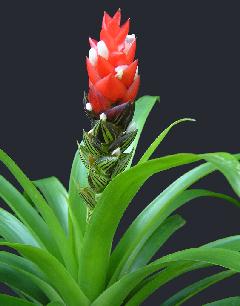
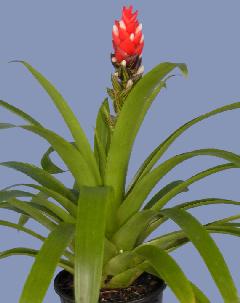
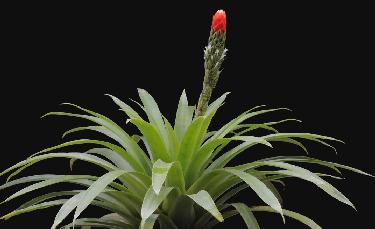
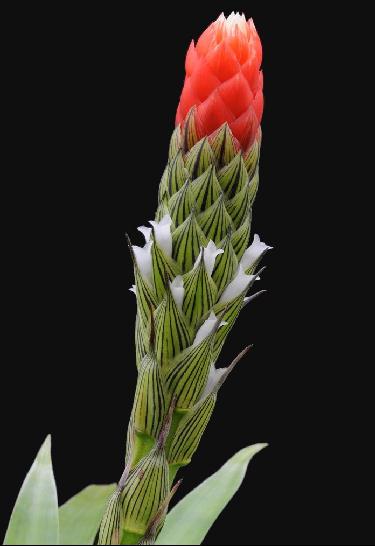
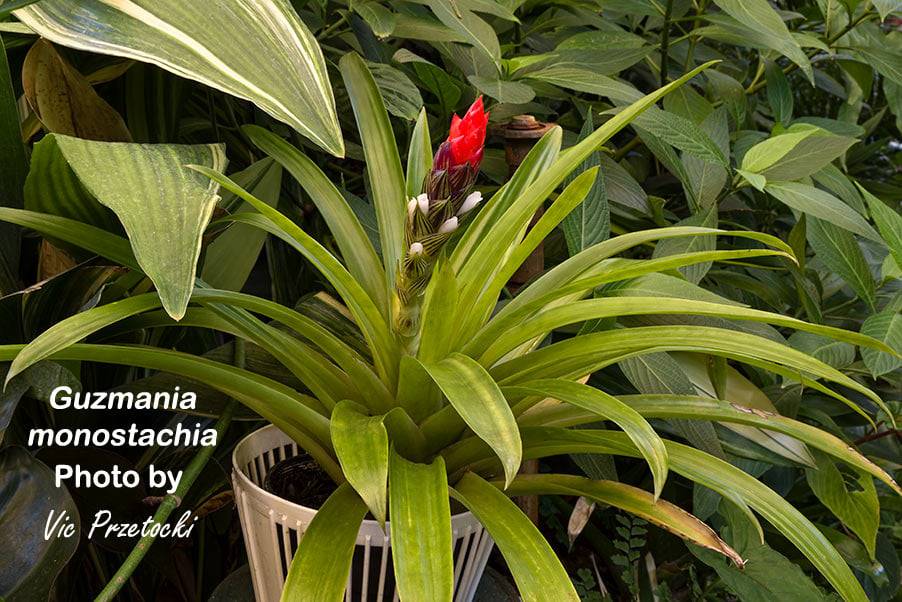
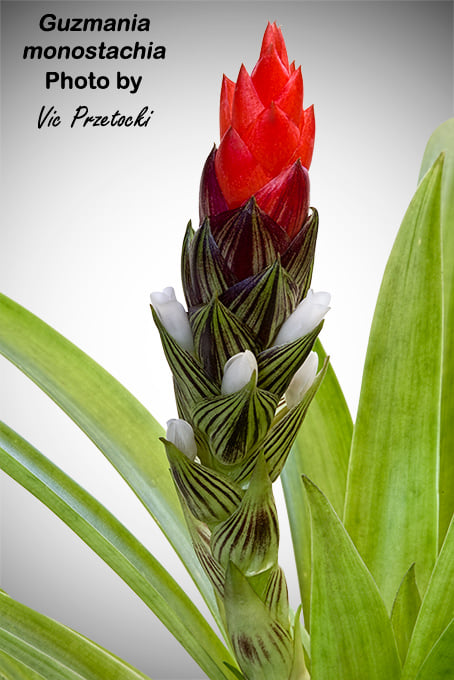
Guzmania monostachia var monostachia
Renealmia non ramosa squamata, & floribus niveis Plumier, Gen. 37. 1703.
Renealmia monostachia Linnaeus, Sp. Pl. 287. 1753.
Tillandsia monostachia (Linnaeus) Linnaeus, Sp. Pl. ed. 2.410.1762.
Tillandsia clavata Lamarck, Encycl. I: 617. 1785. Type. Moustique, Republica Dominicana, Plumier s n (P, icon ined.)
Pourretia sympaganthera Ruiz & Pavon, Syst. I: 82. 1798. Type. Peru, Ruiz & Pavon s n (MA, n v).
Guzmania tricolor Ruiz & Pavon, Fl. Peruv. 3: 38, pl. 261. 1802. Type. Mount Pillao, Chacahuassi, Peru, Ruiz & Pavon s n (MA n v).
Guzmania comosa Bertero ex Schultes filius in Roemer & Schultes, Syst. 7: 1232. 1830. Type. Jamaica, Bertero 2187 (M).
Guzmania sympaganthera (Ruiz & Pavon) Beer, Bromel. 103. 1857.
Tillandsia comosa Bertero ex Grisebach, FI. Brit. W. Indies 598. 1864; nomen in synon. Tillandsia heliconioides sensu Grisebach, Nachr. Ges. Wiss. Gott. "1864"; 18. 1865; non Humboldt, Bonpland & Kunth, 1816. Based on Fendler 2165 (K, K photo 7459), Colonia Tovar, Venezuela.
Tillandsia pachycarpa Baker, Jour. Bot. London 25: 238. 1887. Type. Trinidad, Fendler 829 (K, K photo 7460).
Tillandsia gymnophylla Baker, Jour. Bot. London 26: 41: 1888; nom. nov. for Tillandsia heliconioides sensu Grisebach.
Guzmania maculata Linden Hortus, Cat. 18: 5. ex Baker, Handb. Bromel. 152. 1889; nomen.
Guzmania grandis hortus ex Baker, Handb. Bromel. 152. 1889; nomen
Guzmania fragrans hortus (non Linden Hortus) ex Baker, Handb. Bromel. 152. 1889; nomen.
Guzmania platysepala Mez & C. F. Baker ex Mez, Bull. Torrey Club 30: 437. 1903. Type. Volcano Mombacho, Granada, Nicaragua, C. F. Baker 2345 (B, POM).
Guzmania laxa Mez & Sodiro, Bull. Herb. Boiss. II. 5: 111. 1905. Type. Babahoyo, Ecuador , Sodiro 171/25 (B, B photo 1207/1).
Bromelia tricolor hortus ex Gard. Chron. 43: 257. 1908.
Guzmania clavata (Lamarck) Urban, Repert. Sp. Nov. 15: 99.1917.
Leaf-blades concolorous.
Fertile floral bracts pale with dark brown longitudinal stripes.(or without stripes and coriaceous – see synonym G. laxa)
Type. Plumier s n (P icon ined.), West Indies.
DISTRIBUTION. Epiphytic and sometimes terrestrial in forest, 2-2000 m alt, southern Florida, West Indies, and Nicaragua to northern Brazil and Peru.
UNITED STATES. Florida, Dade County: Cutler to Longview Camp, Nov 1903 (fruit), Small & Carter s n (GH, NY, US); Sykes Hammock, Redland District, 2 Feb 1930, Moldenke 555 (NY, US). NICARAGUA. Bluefields: La Luz to Siuna, 11 Mar 1961, Bunting & Licht 532 (US). Masaya: Las Nubes, 28 Jun 1923, Maxon, Harvey & Valentine 7503 (US); 24 May 1947 , Standley 8695 (F, US). Granada: Volcano Mombacho, 5 Jul 1923, Maxon, Harvey & Valentine 7517 (US\. COSTA RICA. Guanacaste: El Arenal, Jan 1926, Standley & Valerio 45320 (US); 45324 (US); Tilaran, 27 Jan 1926, Standley & Valerio 45320 (US). Alajuela: Los Chiles, Rio Frio, 1 Aug 1949, Holm & Iltis 782 (US). Cartago: Cartago, Feb 1924 (fruit), Standley 33327 (US); Turrialba, 14 Jul 1955, Schubert & Rogerson 852 (US). Without exact locality: Tonduz 17890 (US). PANAMA. Bocas del Toro: Rio Cricamola, Finca St. Louis to Konkintoe, Aug 1938,Woodson, Allen & Seibert 1891 (GH); Isla Colon, 30 Mar 1940, Wedel 70 (GH); Water Valley, Chirigui Lagoon, 20 Nov 1940, Wedel 1706 (MO); Fish Creek, Chiriqui Lagoon, 12 May 1941, Wedel 2448 (GH, US); without locality, Wedel 214-A (MO). Canal Zone: Summit, 4 Jan 1924, Standley 29591 (US); Barro Colorado Island, 1931, Bailey 105 (BH); Shattuck 763 (F); 1934, Aviles 927 (F); Quebrada Salamanca, 16 Dec 1934, Dodge, Steyermark & Allen 17032 (GH); 17035 (GH); Rio Chilibre, Juan Mina to Madden Dam, 9 Jul 1940, Bartlett & Lasser 16422 (MICH); without locality, Werner 53 (MO). CUBA. Isla de Pinos: Nueva Gerona, 19 Jan 1904 (fruit), Curtiss 356 (GH, US); San Juan, Mar 1916 (fruit), Britton, Britton & Wilson 15470 (US); Columbia, Mar 1916 (fruit), Britton, Britton & Wilson 15734 (US). Pinar del Rio: Raugel, 29 Jun 1926, Leon s n (S); Cayajabo, Artemisa, Jul 1938, Carabia 150 (LS). Habana: Santiago de las Vegas, 26 May 1906, Baker 2886 (POM); 2888 (POM). Matanzas: Matanzas, 1849, Rugel 247 e p (BM, CH). Las Villas: Cayamas, 11 Feb 1905, Baker 4609 (POM); Pitajones, Mar 1912 (fruit), Shafer 12271 (NY, US); Soledad, 29 Jan 1928, Jack 6374 (GH); 16 Nov 1928, Jack 6667 (GH); San Blas, Sierra Trinidad, 4 Apr 1928, Jack 6667 (GH); 18 Mar 1929, Bailey 12459 (BH); June 1941, Howard 5365 (GH); Placetas, 3 Jul 1940, Acuna 11137 (US). Camaguey: La Gloria, 2 Feb 1909, Shafer 211(US). Oriente: MonteVerde, 1859, Wright 1520 (GH); El Yunque, Dec 1910, Shafer 7959 (NY, US); 7961(GH); Bayate, 29 Aug 1914, Ekman 2611 (S); 1 Jul 1915, 6191 (S); Rio Piloto, Sierra de Nipe, 17 May 1915 , Ekman 5793 (S); Loma del Garo, Jul 1921, Leon 9974 (LS, US); Santiago, May 1937, Foster VII (GH); Alto de Calabazas, Manzanillo, 19 Mar 1938, Carabia 16 (LS); Monte Picote, Palmarito del Cauto, 29 Jan 1956, Morton 9734 (US); Florida Blanca, Alto Songo, 1 May 1958, Lopez 2881 (US); without exact locality, Wright 677 (GH, US). Without locality: Eggers 5396 (K). JAMAICA. Surrey, St. Thomas: Arntully, Orcutt 5822 (US); St. Andrew: St. Andrews Mountains, Oct. 1843, Purdie s n (K\; Blue Mountains, 19 May 1894, Harris 5145 (GH); Red Hills P. O., 21 Mar 1952, Rugless s n (IJ, US). Middlesex, St. Marys: Konigsberg, 8 Oct 1891, Fawcett s n (BM); St. Catharine, Ewarton, 14 Jan 1952, Proctor 6138 (IJ, US); St Ann: Claremont, 16 Mar 1952, Proctor 6391 (IJ, US). Cornwall, Trelawny: Windsor Estate, 28 Aug 1955, Patrick s n (IJ, US); Manchester: Spaldings, Knox College, 15 Jul 1949, Dignum s n (IJ); St James. Catadupa, 5 Apr 1952, Proctor 5556 (IJ, US); Montego Bay, 14 May 1988, Hummel s n (S); St. Elizabeth: Accompong, 22 May 1953, Proctor 7945 (IJ, US).Without exact locality: Bertero 2187 (M); Browne 113 (LINN); Wright s n (BM); Wullschlagel 1044 (GOET, M); Mount Dakin, 20 Apr l895, Harris 5586 (GH). HAITI. Bayeux, Port Margot, 4 Aug 1903, Nash 119 (NY, US); St. Louis du Nord, 3 Apl 1925, Ekman H-3780 (S); 3 Apr 1929, Leonard 14328 (US); Kalacroix, l'Artibonite, 11 Dec 1925, Leonard 7986 (US); Dondon Dept. Nord, 8 Jan 1926, Leonard 8722 (US). REPUBLICA DOMINICANA. Puerto Plata: Pico Gallo, 18 Sep 1954, Jimenez 2758 (US). Santiago: Jicome, San Jose de las Matas, 27 Dec 1929, Valeur 322 (US); 10 May 1931, 757 (US); 11 May 1933, 988 (US); La Cidra, 8 Apr 1955, Jimenez, Gonzalez & Marcano 2942 (US). Pacificador: Gaspar Hernandez, 8 Apr 1950, Jimenez 2005 (US). La Vega: San Juan, Sep 1946, Howard 8938 (GH); Piedra Blanca, 23 Dec 1947, Allard 18091 (US). Samana: Rio Hato Viejo, 13 Jun 1930, Ekman H-15285 (S). Seibo: Higuey, Nov 1946, Howard & Howard 9507 (US). Without exact locality: Poiteau 330 (P). PUERTO RICO. La Vega, Adjuntas, 22 May 1886, Sintenis 4403 (POM, US); Utuado to Lares, 17 Jun 1901, Underwood & Griggs 109 (US); Hato Tejas, 30 Nov 1963, Liogier 10371 (NY, US); without exact locality, Sintenis 474 (K). COLOMBIA Goajira: Carraipia, 4 Jul 1944, Haught 4237 (US). Norte de Santander: Rio Catatumbo, Teorama, 11 Sep 1946, Foster 1759 (GH); Oru on pipeline, 16 Sep 1946, Foster 1738 (GH); Convencion, 23 Sep 1946, Foster 1759 (GH). Santander, Puerto Berrio, 2 May 1935, Haught 1690 (US). Cundinamarca: Colejio. Rio Bogota, Nov 1856, Triana s n (COL). Valle: La Paila, 23 Mar 1853, Holten 156 (GH, NY, PH); Valley del Cauca, Triana 557 (COL, US\; Zarzal, 20 Jul 1922, Killip & Hazen 8365 (GH); 21 Jul 1922, Pennell, Killip & Hazen 8389 (GH, NY, US); 7 Oct 1946, Cuatrecasas 22102 (F); Tulua, Aug 1943, Dryander 2729 (F, US). VENEZUELA. Nueva Esparta: El Valle, Isla Margareta, 3l Aug 1903, Johnston 295 (GH, US); Isla Margareta, Aug 1955, Bernardi 2444 (NY); without locality, Gines 3589 (US). Monagas: Caripe, 17 Apr 1945, Steyermark 62167 (F, GH). Distrito Federal: Naiguata, 3 Nov 1963, Steyermark 91893 (US, VEN). Falcon: Cerro Santa Ana, Peninsula de Paraguana, Jan 1939,Tamayo 847 (VEN); 24 Jan 1966, Steyermark & Braun 94630 (US, VEN); 18 Jul 1967, Steyermark 99077 (VEN). Zulia: Rio Yasa, Sierra de Perija, 25 Aug 1967 , Steyermark & Fernandez 99678 (US, VEN). TRINIDAD. San Fernando, Herb. Trinidad 827 (TRIN); Arima, 1890, Broadway s n (TRIN); 1904, Dannouse s n (TRIN); 1943, Pittendrigh 1155 (US); Maracas, 1927, Broadway 6598 (K); St. Augustine, 1929, Beattie s n (TRIN); St. Ann's, 1931, Broadway (GH); Valencia road to Oropuche River, 1931, Broadway 7585 (GH); Guaico, 3 Jun 1956,Aitken 189 (US); Tamana, 10 Jun 1944, Pittendrigh 1015 (US); 11 Dec 1943, 1016 (US); s d,, 1309 (TRIN); Cumuto, Pittendrigh 1528 (TRIN); Coora Road, McCullum 231 (TRIN); Brazil-Talparo, 25 Jan 1948, Simmonds 255 (TRIN, US); without exact locality, Crueger s n (TRIN); Fendler 821 (K). TOBAGO. Mason Hall, 5 Jun 1913, Broadway s n (GH, NY, TRIN, US); 4 Aug 1913, 4688 (GH); Aitken s n (TRIN); 80 (TRIN). ECUADOR Esmeraldas: Viche, 29 May 1955, Asplund 16513 (S, US); Limones to San Lorenzo, 24 Feb 1959, Harling 4275 (S, US). Guayas: Babahoyo, Andre 375 e p (K); San Lorenzo, 9 Feb 1962, Gilrnartin 601 (US); Guayaquil, 20 Apr 1962, Gilmartin 684 (US); Manglaralto, 2 May 1962, Gilmartin 694 (US); km 80, Guayaquil to Quevedo, 2 Aug 1965, Gilmartin 1053 (US); km 98, 1054 (US). Oro: Santa Rosa to La Chorita , 27 Aug 1923, Hitchcock 21135 (US); Portovelo, Zaruma, 1923, Hitchcock 21248 (US); 21250 (US); Piedras to Pinas, 14 Oct 1955, Asplund 18182 (S); Passaje, 28 Aug 1957, Rauh & Hirsch E-9 (US). Carchi: Ibana to San Lorenzo, 14 Dec 1961, Dodson & Thien 1549 (MO). Bolivar: Guaranda to Bodegas, Nov 1856, Remy s n (P). Chimborazo: Chimborazo to Guayaquil, 21 Dec 1879, Lehmann s n (W); Huigra, 21 Nov 1933, Schimpf 467 (G, MO, Z). PERU. Tumbez: Hacienda Chicama, Tumbez, Feb 1927, Weberbauer 7643 (F, GH). Piura: Canchaque, 4 Oct 1954, Rauh & Hirsch P-2126 (US); 26 May 1957, Ellenberg 1615 (U). San Martin: San Roque, 1910,Williams 7238 (F, US). BRAZIL. Ceara: Riacho do Capim, Sep 1897, Huber s n (MG); Serra de Baturite, 23 Apr 1909, Ducke s n (MG); Serra de Maranguape, 24 Nov 1955, Lima 55-2361 (IPA).
Tillandsia pachycarpa Baker, Jour. Bot. London 25: 238. 1887. Type. Trinidad, Fendler 829 (K, K photo 7460).
36. T. pachycarpa, n. sp.
Leaves densely rosulate, above a foot long, linear-lanceolatefrom a dilated base 1½ in. broad; blade rigidly coriaceous, not lepidote, ½ - 3/4 in. broad low down; apex not setaceous. Peduncle much shorter than the leaves; bract-leaves small. Spike dense, simple, 3-4 in. long; flowers 8-9 on a side, erecto-patent; flower-bracts ovate-oblong, obtuse, ¾ in. long. Calyx ½ in. long; sepals obtnse. Corolla not seen. Capsule an inch long; valves very thick and woody.
Hab. Trinidad, Fendler 829!
From Baker 1889
190. T. GYMNOPHYLLA Baker in Journ. Bot. 1889, 41.
T. heliconioides Griseb. non H. B. K.
Leaves few in a rosette, lanceolate from a slightly dilated base, a foot long, ½ - ¾ in. broad at the middle, thin, subglabrous, acute. Peduncle arcuate, shorter than the leaves. Spike simple, moderately dense, 3-4 in. long; flowers appressed to the axis; flower-bracts oblong-lanceolate, glabrous, ½ in. long. Calyx nearly as long as the bract. Petals not seen.
Capsule-valves lanceolate, an inch long.
Hab. Mountains of Venezuela, Fendler 2615!
Guzmania monostachia var variegata hortus ex Nash in L. H. Bailey, Standard Cyclopedia of Horticulture 2: 1419. 1935; nomen illeg.; Foster, Bromel. Soc. Bull. 3: 30. 1953.
Leaf-blades longitudinally green- and white-striped.
Bracts as in the typical variety.
Type. M. B. Foster 2830 (holotype US), on trees, in Big Cypress near Deep Lake, Collier County, Florida, United States.
DISTRIBUTION. Known from the type collection only.
Guzmania monostachia var alba Ariza - Julia, Bromel. Soc. Bull 9: 38, fig. 1959.
Leaves concolorous.
Floral bracts wholly green, the upper sterile ones pure white.
Type. Ariza-Julia in herb. Jimenez 3712 (holotype US), on tree, Hacienda "Las Palmas," Seccion Cabia, Imbert to Guananico, Puerto Plata, Republica Dominicana.
DISTRIBUTION. Known from the type collection only.
The variegated variety of Guzmania monostachia was first found sometime before 1935 as it was listed in L.H. Bailey's Standard Cyclopedia of Horticulture published that year. It evidently soon vanished from cultivation. In 1953, Mulford Foster again described it in the Bromeliad Society Bulletin, volume 3, page 30, as a native of Collier County, Florida, "in Big Cypress near Deep Lake." He credited Roy Woodbury of the University of Miami with the discovery. Prof. Woodbury was also the first to collect Tillandsia pruinosa Swartz in the same area of the Big Cypress.
Guzmania monostachia is found in several rather extensive colonies in Collier, Dade, and Monroe counties of Florida. It is also very common and widespread in the Neotropics from Nicaragua and the Caribbean to Bolivia and northern Brazil, but the variegated variety was until now thought to be endemic to one site in the Big Cypress Swamp.
Panamanian plants of Guzmania monostachia var. variegata are very similar to those of Florida. The plants vary in diameter from 30 to 65 cm with thin, pale green leaves irregularly striped with white. The Panamanian plants differ in one characteristic that will undoubtedly add to their horticultural appeal: the brightly colored inflorescence. The flowers of G. monostachia from Florida are autogamous (self-pollinating) and the inflorescence is not attractive to potential pollinators; the floral bracts are pale, usually pink or flesh colored. In contrast, the Panamanian plants are normally outcrossing and, based on my unsuccessful attempts to produce seed, they appear to be self-sterile. Their apical floral bracts are brilliant red and obviously more conspicuous to animal pollen vectors.
Variegated plants appear to be relatively common in the one small population observed in Panama.
Guzmania monostachia (Linnaeus) Rusby ex Mez var variegata hortus ex Nash.
PANAMA. Bocas del Toro: vic. of Chiriqui Grande, ca. 10 m. elev., June 1986, Luther, Besse, Halton, & Kress, s.n. Fl. in cult. at Selby Gardens, Dec. 1986, E. A. Christenson & N. Vecchio 1655 (SEL).
Notes by Butcher May 2011.
Guzmania laxa Mez et Sodiro in Bull. Herb. Boiss. 2. ser. V. 111. 1905
Treated as a separate species by Gilmartin in 1972, treated as a synonym of G. monostachia in S&D without amendment to description. Type material in B is noted as being G. fuerstenbergiana by Till in 2005 but not published. Luther considers that G. fuerstenbergiana is a natural hybrid between G. monostachia (Sensu Smith? and thus including G. laxa) and G. remyi. Reluctantly I follow Smith BUT have amended his description of Guzmania monostachia. As part of this scenario I have a stiff, narrow triangular trichomed leaved plant from Knize (Peruvian collected) that flowered like G. monostachia but if I had used the key in Mez 1935 I would have had to consider G. fuerstenbergiana!
From Mez 1935
28. G. laxa Mez et Sodiro in Bull. Herb. Boiss. 2. ser. V. (1905) 111.
Acaulis, ad 0,4 m alta. Folia ad 0,4 m longa, super vaginam ad 28 mm lata, inde in apicem persensim. angustata, subglabra, apice subpungentia. Scapus foliis subduplo brevior, gracilis, lepidibus brunnescentibus furfuraceus, laxe vaginis inflato-concavis, ex ovato-elliptico omnibus in laminas angustas acuminatim productis, stricte ercctis, internodia multo superantibus indutus. Inflorescentia simplicissima, submultiflora, folia aequans, basi laxiuscula apicem versus densior, summo apice sterilis, ad 0,16 m longa et 22 mm diam. metiens; bracteis coriaceis, haud farinosis, inferioribus saltem petala superantibus, ex sicco concoloribus nec vittatis, inferioribus manifeste remotis vix imbricatis, mediis ad 23 mm longis. Flores sessiles, ad 27 mm longi, glabri; sepalis paullo ultra ⅓ connatis, rigidis, basin versus castaneis, 16 mm longis, nitidulis, paullo asymmetrice ellipticis anguste rotundatis. Petala 26 mm longa, alte tubulose coalita, lobis anguste ellipticis, rotundatis, stamina ad 5 mm superantibus.
Ecuador: bei Babahoyo (Sodiro n. 171/25).
Translated by Butcher
Plant acaulis, to 0,4 m high. Leaves to 0,4 m long, above sheath to 28 mm wide, then gradually narrowing to the tip, subglabrous, tip almost pungent. Scape under twice as short as the leaves, slender, brownish furfuraceous lepidote, lax bracts with sheaths inflated-concave, from ovate-elliptic, all producing, narrow acuminate blades, strictly ercct, much exceeding the internodes. Inflorescence simple, submultiflowered, equalling the leaves, becoming lax at the base and denser toward the top, top section sterile, to 0,16 m long and 22 mm diam.; floral bracts coriaceous, not at all farinose, the lower ones at least exceeding the petals, when dry concolorous not at all vittate, lower ones clearly remote barely imbricate, middle ones to 23 mm long. Flowers sessile, to 27 mm long, glabrous; sepals a little over ⅓ connate, rigid, chestnut brown towards the base, 16 mm long, shiny, a little asymmetric elliptic narrow rounded. Petals 26 mm long, coalesced into a tall tube, lobes narrow elliptic, rounded, stamens exceeding to 5 mm.
Ecuador: near Babahoyo (Sodiro n. 171/25).
From Gilmartin Brom Ecuador 1972
7. Guzmania laxa Mez and Sodiro, 1905 (Bull. Herb. Boiss. series 2, vol. 5) p. 111; Smith, 1932, p. 26.
PLANT stemless, ca, 45 cm tall;
LEAVES 30-45 cm long, blades ca. 2.8-4.0 cm wide, lingulate, apex attenuate, sheath 5.0-7.0 cm long by ca. 4.0 cm wide, apparently concolorous with blade, outermost leaves shorter, ca. 3.0-9.0 cm long;
SCAPE 4-7 mm in diameter, erect, much exceeded by leaves;
SCAPE-BRACTS 4.0-7.0 cm long, erect, imbricate but scape partially exposed, apices acute;
INFLORESCENCE ca. 15 cm long by 2.5 cm in diameter, simple, lax below, dense above, terminal floral bracts sterile, having ca. 30 flowers, axis tomentose;
FLORAL BRACTS 2.4-2.7 cm long by ca. 1.3 cm wide, elliptic, coriaceous, apices acute;
SEPALS ca. 1.6 cm long, elliptic, broadly rounded, surface lustrous;
PETALS ca. 2.6 cm long, erect;
CAPSULE ca. 3.0 cm long by 1.0 cm in diameter just prior to dehiscence, coma white.
MATERIAL EXAMINED: Sodiro 171 125 (B, TYPE; US, photo) near Babahoyo, Prov. Los Rios, probably ca. 100 m, Dec. 1890; AJG 1174 (US) Las Delicias, road between Guayaquil and El Tambo, Prov. Canar, ca. 650 m, 14 Aug. 1965; AJG 1175 (US) Las Delicias, road between Guayaquil and El Tambo, Prov. Canar, ca. 650 m, 14 Aug. 1965.
The neotropical genus Guzmania Ruiz & Pavon has more than 160 species (Smith & Till 1998). In Cuba it is represented by Guzmania monostachia (L.) Rusby ex Mez, G. lingulata Mez and G. erythrolepis Brong. ex Planch.
Guzmania monostachia is the most abundant and widely distributed, occurring throughout the archipelago. Typical of humid forests, this species is found from sea level to 1600 m elevation (Villalon 1996) as an epiphyte in dense canopies or in limestone solution holes with accumulated organic matter where sunlight reaches the lowest layers of the forest (Hechavarria 2002). According to Smith & Downs (1977).
Guzmania monostachia has three known varieties: the typical variety, monostachia, G. monostachia var. alba Ariza Julia, and G. monostachia var. variegata M.B. Foster. Smith and Downs only reported the typical variety for Cuba.
On a recent expedition to the Alturas de Banao Ecological Reserve, located in the mountainous Guamuhaya region in central Cuba, the varieties alba and variegata were found. Variety variegata was previously known only for its type location in southern Florida in the United States (Smith & Downs 1977) as well as the Bocas del Toro Province in Panama (H. Luther, pers. com.) There are six main vegetation zones at Alturas de Banao: broadleaf semi-deciduous forest, karstic vegetation complex (known as Mogotes, in the broad sense, not the typical Mogote geomorphology limited to Pinar del Rio, Western Cuba), montane rain forest, gallery forest, broad leaf evergreen forest, and secondary vegetation. This area contains more than 900 plant species, of which nearly 25% are endemic (Becquer, unpublished data). From the geomorphological point of view, the area that includes the upper river basin of the Banao and Higuanojo rivers is characterized by low mountains (200-843 m elevation), strongly dissected in some cases with karstic caps (Smith et al., unpublished data). The climatic conditions, according to Perez (unpublished data), range as follows: annual average temperature: 22-26°C, annual average precipitation: 1700-2000 mm and annual average relative humidity 81-90%.
Between the Jarico Administrative Station and the Maria Antonia and Sabina Biological Stations, is a gallery forest along the Banao river (FIGURE 10). The forest is composed mainly of the exotic species, Syzygium jambos (Myrtaceae), which is naturalized to the island and well-known locally by the name "pomarrosa". At approximately 400 m elevation, the pomarrosa is the main host to the three varieties of Guzmania monostachia, sometimes all occurring on the same tree. The more abundant varieties are monostachia and alba, whereas variegata appears with few individuals. Other epiphytes include the bromeliads Tillandsia festucoides, T. setacea, T. variabilis, and T. bulbosa, the ferns Pleopeltis polypodioides, Phlebodium aureum and Campyloneurum phyllitidis, the orchid Epidendrum nocturnum, the peperomias Peperomia magnolifolia and P. obtusifolia, and the hemiepiphytic climber Marcgravia rectiflora.
Varieties monostachia and alba bloom at the beginning of the rainy season in Cuba at the end of April, through most of May. The brilliant red and black striped floral bracts of var. monostachia (FIGURE 11) contrast with the green and immaculate white bracts of variety alba (FIGURE 12). Also growing in the pomarrosa trees are plants of Guzmania monostachia with pale rose floral bracts which suggest the probable occurrence of a new variety (W Till, pers. com.). As in the typical variety, the rest of the floral bracts are pale green colored, but light and diffusely striped (FIGURE 13). Variety variegata (FIGURE 14), does not bloom in this season, which suggests the existence of a possible mechanism of reproductive isolation. This strip of Gallery Forest is a favorable site for studies of reproductive biology of Guzmania monostachia to further the knowledge of the natural history of the species in Cuba.
Although dried specimens of variety monostachia have some vestiges of dark stripes in the floral bracts, the differences between the other varieties of G. monostachia disappear almost completely once collected material is dried and pressed, which makes their identification to variety level in the herbarium difficult (Villalon 1996).